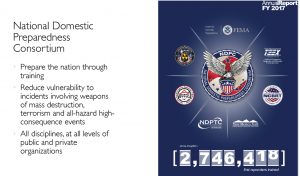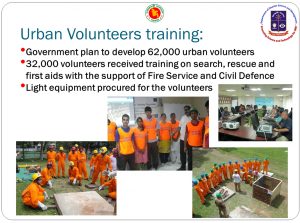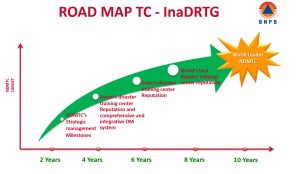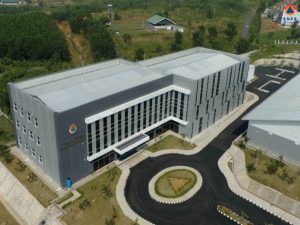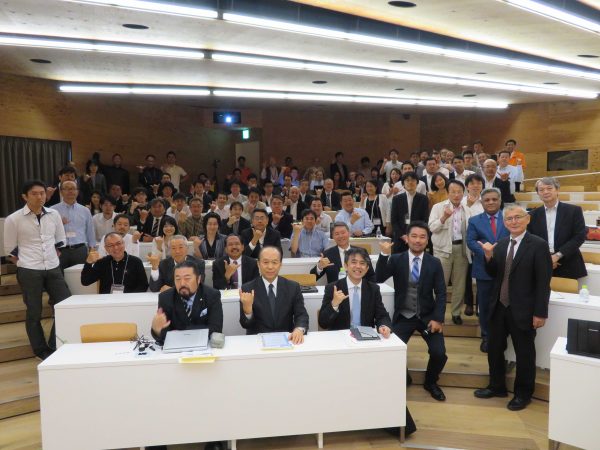
June 14, 2018
災害 対応トレーニングに関する国際シンポジウムInternational Symposium for Disaster Management Training: What is the future of disaster management training?
2018年5月23日に東京大学ダイワユビキタス学術研究館において、第一回災害対応トレーニングに関する国際シンポジウムが開催されました(図1)。過去、我が国において複数の国の災害対策を同時に学べる機会はほとんどなかったため、本シンポジウムは、各国の災害対策を集中的に学べる絶好の機会でした。
災害対応従事者は、曖昧な情報の中で意思決定が求められ、かつ多くの業務をこなす必要があります。そのためには、状況認識を統一し、活動目標を共有・達成手段を合意した上で、担当者を決定・調整するなど、基本的なマネジメント能力が求められます。しかし、我が国は、災害対応のトレーニングカリキュラムが体系的に整備されておらず、また事前に実効性の高い訓練ができていないため、実際の災害対応では非効率な災害対応となることが多いです。そもそも災害発生後の混乱した状況の中で、多くの行政職員は何をやったらよいのかが分からない状況に陥っています。一般的にこの状況は被災市町村で最も顕著ですが、都道府県や中央政府であっても、改善の余地は大きいです。
そこで本シンポジウムでは、各国の災害対応のトレーニングの現状や将来ビジョンを学ぶことで、我が国に適した災害対策トレーニングの仕組みを考え、体系的なトレーニングカリキュラムを構築、実効性の高い訓練環境のあり方を考えることを目指しました。
本シンポジウムは、米国のハワイ大学、バングラディッシュのダッカ大学、インドネシアの国家防災庁、ミャンマーのヤンゴン工科大学から各国の災害対策体制やトレーニング制度に関する発表がありました。日本からは、田中秀幸学環長、田中淳総合防災情報研究センター長、目黒公郎教授、伊藤哲朗客員教授(元内閣危機管理監)からご発表がありました。
ハワイ大学のRussell教授からは、米国のFEMA(危機管理庁)の位置づけなどについて詳細なご発表がありました。米国は、複数の大学を中心とした組織でコンソーシアムを形成し、トレーニング内容等を共有している点に特徴があります(図2)。ダッカ大学のKamal教授からは、バングラディッシュの防災局の実践的な訓練について発表があり、訓練アカデミーの創設など国家主導でトレーニングの仕組みを構築していることが分かりました。今後、62,000名のボランティアへの実践的な訓練計画があるなどの紹介がありました(図3)。インドネシアの国家防災庁のWisnu次官からは、INDONESIA DISASTER RELIEF TRAINING GROUND/ INA DRTGの紹介があり、2024年までにWorld’s best disaster training center reputationとなるロードマップの紹介がありました(図4)。INA DRTGは、13部屋に150ベッドが用意されているなど、訓練環境も整備されています(図5)。ミャンマーにおいてもDDM (Department of Disaster Management)がDisaster Management Training Centerを建設し、2016年から約1700名が受講しているなどの紹介がありました。
本シンポジウムで発表された国では、着々と実践的な訓練環境の整備が進んでおり、各国から我が国にも基礎知識から実技までをカバーした実践的な災害対応トレーニングの必要性が強調されました。
東京大学では、知の協創の世界拠点を目指しており、これを実現するためには、国際レベルで実効性の高いトレーニングプログラムの提供、これを支える研究の両輪を回す必要があります。今後、日本政府は海外からの観光客数を2020年には4000万人を目指しており、首都直下地震など大規模災害が発生した場合には、宗教上の配慮など国際標準での災害対応が求められます。そのためには、災害対応のトレーニングを国際的な観点で整備する必要性はますます高まっています。
記事:沼田宗純(講師)
On May 23, 2018, the International Symposium on Disaster Management Training was held at Daiwa Ubiquitous Academic Research Center, The University of Tokyo (Figure 1). In the past, there were few opportunities to learn about disaster countermeasures from multiple countries at the same time in Japan, so this symposium was a great opportunity to intensively learn about disaster countermeasures from each country.
Actual disaster response operations are often inefficient, because the disaster response training curriculum has not been systematically developed and highly effective training has not been done in advance in Japan. In the initial stages of confusion immediately after a disaster, many administrative officials find themselves in a situation of not knowing what to do.
This symposium considered systematic training curriculum development and a highly effective training system that are suitable for our country by understanding the current situation and future vision of disaster response training in each country.
Invited Presenters were Russell Uyeno (University of Hawaii), Maksud Kamal (University of Dhaka), B. Wisnu Widjaja (BNPB), May Myat Mon (Yangon Technological University). From Japanese side, Hideyuki Tanaka (UTokyo), Atsushi Tanaka (UTokyo), Tetsuro Ito (UTokyo), Kimiro Meguro (UTokyo) and Muneyoshi Numada (UTokyo) gave presentations.
Professor Russell of the University of Hawai’i gave a detailed presentation on the activities of the US FEMA (Crisis Management Agency). The United States features a consortium of universities and public organizations with training content sharing. (Fig. 2). Professor Kamal of the University of Dhaka explained the practical training of the disaster prevention bureau in Bangladesh and the establishment of a training academy. There is also a plan to provide practical training programs for 62,000 volunteers (Fig. 3). Mr. Wisnu from BNPB gave an introduction to INDONESIA DISASTER RELIEF TRAINING GROUND/INA DRTG, and a road map that had achieved the world’s best disaster training center reputation by 2024 (Figure 4). INA DRTG has training facilities, including accommodation with 150 beds in 13 rooms (Figure 5). Also in Myanmar, the Department of Disaster Management (DDM) built a Natural Disaster Management Training School in Hinthada. About 1,700 people have already attended since 2016.
The development of a practical training environment for disaster management has been progressing steadily in the countries presented at this symposium. The necessity of practical disaster management training in Japan, covering all aspects from basic knowledge to practical skills, has been emphasized from each country joining this symposium.
The University of Tokyo tries to serve as a global base for knowledge collaboration based on the Vision 2020. To achieve this vision, both a highly effective training program at the international level and academic research are necessary. The Japanese government is aiming for the number of tourists from overseas to reach 40 million people in 2020, and in a large-scale disaster, disaster management must be organized in accordance with international standards with consideration to religious care. To that end, there is a growing need to develop disaster management training from an international perspective.
Text: Muneyoshi Numada (Lecturer)
Proofreading: David Buist (Project senior specialist)


